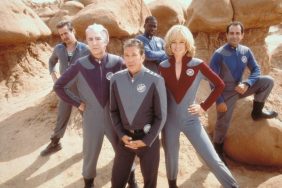
Benny, a modest man who lives in the black portion of town, begins having an inspiration to write a story about, well, Deep Space Nine, a space station with a negro commander. His firm constantly tells him this story is unpublishable because of the racial overtones, but Benny has been so inspired, he becomes obsessed. He even begins seeing characters from his story (i.e. characters from the show) appearing on the street next to him. Eventually Benny breaks down, refusing to compromise, insisting that his creative inspiration and the quality of his writing are being ignored entirely over the simple matter of his race. Just as he does so, Benny wakes up back on Deep Space Nine, once again as Benjamin Sisko. Did he dream of being Benny, or is Benny dreaming of them?
This is “Star Trek” existentialism at its finest. I’ve always loved conceits on fictional shows that call their fictionality to attention (essentially, when the fourth wall is deliberately broken), and “Far Beyond the Stars” calls the entire show’s reality into question.

In so doing, “Star Trek: Deep Space Nine” can openly indicate how daring it is being. By putting the premise of the show in a fictional context, we can begin to look at it objectively. And what we have, objectively, is a perhaps-pulpy but daring premise about how science fiction can be used to explore modern-day social issues like racism. In short, “Far Beyond the Stars” is an essay about what “Star Trek” has been doing from the very start.
This may seen self-congratulatory, were DS9 not actually daring in one important way: It features a black captain. Sure, by 1998 racist and discriminatory laws were relics of a bygone era, but there is still a lingering race bias in sci-fi; black characters still typically aren’t featured as heavily in movies and TV than perhaps they ought to be, and are certainly not often featured in central roles in sci-fi and fantasy shows. We had seen black characters in “Star Trek” before, of course (Lt. Uhura, Geordi La Forge, and Guinan all spring immediately to mind), but this was the first time the show’s main character was a black man.

Avery Brooks, through his soulful performance and deft direction brings how revolutionary “Deep Space Nine” really was in its racial openness. Captain Sisko is black, and the show actually bothers to create a black culture in the future. Brooks is a soulful man, and he gives deeply spiritual interviews about his creative impulses – no mere actor-for-hire was he – and you can see his interests and influences in full force in “Far Beyond the Stars.” If any episode can be considered an “auteur” episode, it’s this one.
In addition, there’s also the fun examination of the history of sci-fi. There was a time when the most daring and interesting science fiction came largely from fantastical anthology pulp novels and comics. Thanks to “Star Trek,” we tend to take notions of sci-fi canon to a further extent, and take our sci-fi “mythologies” a bot more seriously. “Far Beyond the Stars” seeks, I think, to shake us out of our myth-based nerd complacency, and look at science fiction in a larger historical context.

Plus, it’s just fun to play spot-the-cast member with this episode. Rene Auberjonois, Armin Shimerman and Michael Dorn all play alien characters (a changeling, a Ferengi, and a Klingon respectively) all with elaborate facial ridges, and here they finally get to play roles outside of their makeup. Even supporting alien actors like Marc Alaimo and Jeffrey Combs have cameos. It’s a fun game for fans of the show.
Sorry I strayed so far afield for my pick for Best Episode – this is a stand-alone show that has nothing to do with the rest of the series, and takes place largely off of the station, devoid of the usual characters, aliens, and actual deep space – but it truly is the most interesting episode of the show.
Witney Seibold is a featured contributor on the CraveOnline Film Channel, and co-host of The B-Movies Podcast. You can read his weekly articles Trolling, Free Film School and The Series Project, and follow him on “Twitter” at @WitneySeibold, where he is slowly losing his mind.







